
Project: HiCAD Steel Engineering
"Civil Engineering functions" docking window > Steel Engineering > Connections > Individual beam/profile > Base plate + Anchor plate (2101) 
Use this function to insert base plates and anchor plates for columns (vertical beams). Insertion can take place with welded plates and anchor plates, complete with shear connectors and head studs or anchors with inserts. The insertion of ribs as additional stiffening elements on flanges and webs, or the applying of galvanization holes are also possible.
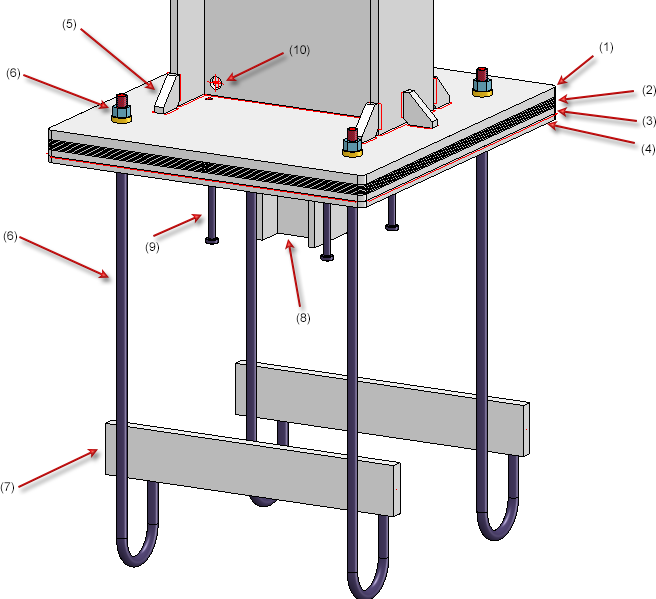
(1) Base plate, (2) Filler plates, (3) Welded plate, (4) Anchor plate, (5) Ribs, (6) Bolting, (7) Insert, (8) Shear connector, (9) Head studs, (10) Galvanization holes
Proceed as follows:
Identify the beam. The Base plate+Anchor plate (2101) dialogue window will be displayed.
Click the Preview button if you want to display a preview of the connection based on the currently entered data. If you want to modify the current data, apply the required changes and click Preview again to update the preview. Click OK to insert the connection according to the current data and close the dialogue window. If you click the Cancel button, the window will be closed, and the specified or changed connection will not be inserted.
Symbols:
|
|
Selected parts Click on this symbol to show information on the previously identified beams, such as the type of the beam, the material, the dimensions, etc. Value inputs and changes are not possible here.
|
|
|
Invert concerned connection values horizontally Click on this symbol to switch specified values horizontally, i.e. right and left. For instance, this can be done for
|
|
|
Invert concerned connection values vertically Click on this symbol to switch specified values vertically, i.e. top and bottom. For instance, this can be done for
|
|
|
The settings in the dialogue window can be saved as Favourites and reused at any time. To do this, click on the |
Notes on assembly structures:
When you insert the Base plate + Anchor plate connection, the following assemblies will be created (depending on the current configuration) as a result:
 Assembly of beam
Assembly of beam  Assembly of beam
Assembly of beam  Assembly of beam
Assembly of beam  Assembly of anchor plate
Assembly of anchor plate  Assembly of anchor plate
Assembly of anchor plate  Assembly of anchor plate
Assembly of anchor plate
 Please also note:
Please also note:
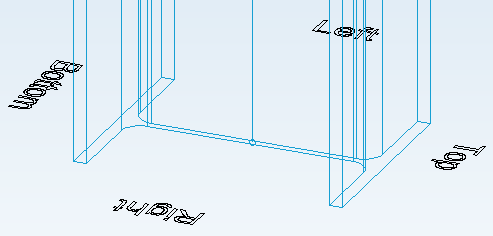
The base plate/anchor plate connection is defined by the settings on the following tabs of the dialogue window:
Here you specify type and size of the base plate, weld-on plate and anchor plate and their alignment in relation to the selected beam.
The settings for the different plates takes place on the sub-tabs on the left side of the window. Anchor plates and welded plates are only inserted if you have activated the Create checkbox on the corresponding sub-tab.
|
Create |
Anchor plates and welded plates are only inserted if you have activated this checkbox on the corresponding sub-tab. |
|
Congruent (Base plate) |
If you want the anchor plate or welded plate to be congruent with the base plate, activate this checkbox. no value inputs in the Vertical/Horizontal fields will then be required. |
|
Semi-finished product |
Click the |
|
Vertical |
|
|
Horizontal |
|
|
Clearance |
If desired, enter a value for the clearance here, i.e.
|
|
Fillet corners |
If you want the corners of the plate to be filleted, activate this checkbox and enter a fillet radius. |
|
Shorten beam by plate thickness |
Activate this checkbox if you want to shorten the beam by the thickness of the plate that is to be mounted onto the beam. The thickness of pre-planned filler plates and the clearance of the base plate (distance to beam) will be taken into account in the process.
|
|
Rotate (Flat steel) |
Various semi-finished product types, e.g. flat steel, offer the option to rotate the plate before insertion: To do this, activate the checkbox. |
Here you specify whether the fixing is to be done by means of boltings or threaded studs.
To do this, activate the corresponding Fit checkbox. The relevant input fields will then be active.
Boltings
If you want the fixing to be done by means of boltings, activate the Fit checkbox here and specify the components of the bolting by clicking on the  symbol. The procedure is similar to that for the New bolting/riveting function. All plates will then be bolted together.
symbol. The procedure is similar to that for the New bolting/riveting function. All plates will then be bolted together.
Instead of the boltings you can also insert only bores, i.e. the plates will only be pre-drilled. To do this, activate only the Bores checkbox.
Beneath Assignment you determine to which assembly the boltinmgs are to be assigned. If the option Loose part has been activated, the boltings will be placed into a separate assembly. If the option Assembly has been activated, the bolting assembly will be assigned to the column assembly.
Inserts
If the Fit checkbox beneath Boltings has been activated, the Inserts area will also be made available for inputs.
If you want to fit Inserts, activate the corresponding checkboxes here. Click the  icon and choose the part from the catalogue. Specify the length. Activate the Rotate 90° checkbox to rotate the part before insertion.
icon and choose the part from the catalogue. Specify the length. Activate the Rotate 90° checkbox to rotate the part before insertion.
Threaded stud
If you want the fixing to be done with threaded studs, Activate the Fit checkbox here - the areas Boltings and Inserts will then be greyed out. Select the desired stud (Semi-finished product) , Nut and Washer. Base plate and welded plate will then be connected by means of the threaded studs.
Usage (Assembly)
Here you can specify the usage of the selected beam and the shear connector. If a usage has already been assigned to the assembly of the beam, the Overwrite usage checkbox can be used to specify whether the existing usage is to be kept or replaced by the usage type selected on the Fixing tab.
Please note that the usage can only be set before the creation of the assembly structure. As soon as you click the Preview button or the OK button, a change is no longer possible.
The bore grid determines the arrangement of the bores, the boltings and the threaded studs on the plate.
For both the horizontal and the vertical settings you need to select a reference first. Further inputs are then dependent on the selected reference.
|
Horizontal - Reference |
Inputs |
|
Distances to plate edge |
|
|
Inner distance
|
|
|
Distances to web |
|
|
Vertical - Reference |
Inputs |
|
Centred (Front plate) |
|
|
Ref. beam, upper edge |
|
|
Front plate, top |
|
|
Ref. beam, lower edge |
|
|
Front plate, bottom |
|
You can use different vertical distances between bores. If you want all vertical distances between bores to be equal, the easiest way to achieve this is to enter the desired distance value in one input field and click the Equidistant  icon. All input field will then be filled with the same value.
icon. All input field will then be filled with the same value.
Here you specify whether you want to apply holes for galvanization processes to the base plate and the reference beam. Activate the corresponding sub-tabs on the left hand side for this purpose.
On beam
Here you select the desired processing. Possible are the following settings:
Base plate
Use the checkboxes to specify which bores are to be created. Enter a hole diameter and the minimum distance to web and flange.

(1) Processings on beam: Holes, holes in plate, (2) Processings on beam: Web cut at top/bottom, holes in plate
Here you specify, by activating or deactivating the checkboxes, which weld seams are to be created between beam and base plate. The following options are possible:
For each edge you can select a type of thickness designation, the weld seam thickness, the weld seam type and the inspection category. If you want to use the same settings for the other edges, click the Equate  icon.
icon.
In addition, you can specify here whether weld seams are to be inserted
To do this, activate the Fit checkbox and enter the weld seam thickness. In the listbox for the Inspection category you can select the test/inspection method according to DIN EN 1090. These inspection categories are predefined in the Configuration Editor at Modelling > Weld seams. They will be evaluated during creation of Weld Seam Test Protocols.
For the welded plate you can select a weld seam type from a listbox.
 For continuous HV and HY weld seams, enter 0 as the weld seam thickness.
For continuous HV and HY weld seams, enter 0 as the weld seam thickness.
If you want filler plates to be fitted between base plate and welded plate, you can specify the number of plates, the type and the size of these plates here.
The following geometry types are available:
Enter, depending on the selected geometry type, the required distances and a value for the hole clearance. The hole clearance always refers to the bolting.
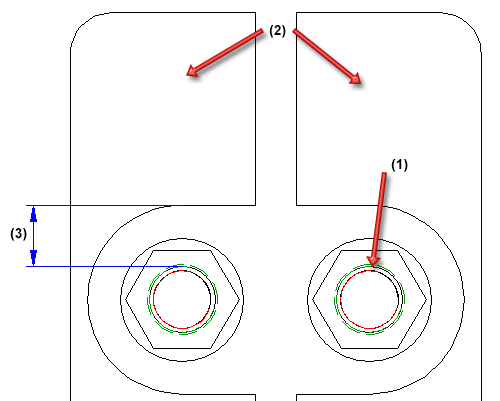
(1) Bolt diameter, (2) Two-piece filler plate, (3) Hole clearance
Beneath Manage you can specify the number of the filler plates.
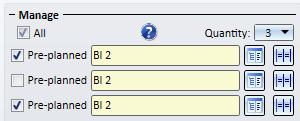
For each filler plate, select the desired sheet type from the catalogue  and specify, by activating or deactivating the corresponding checkbox, whether the filler plate is to be pre-planned or not. If the filler plate has been defined as "pre-planned", the beam will be shortened by the thickness of the filler plate. Non-pre-planned filler plates will be created beside the beam.
and specify, by activating or deactivating the corresponding checkbox, whether the filler plate is to be pre-planned or not. If the filler plate has been defined as "pre-planned", the beam will be shortened by the thickness of the filler plate. Non-pre-planned filler plates will be created beside the beam.
Use the  icon to apply the settings on one filler plate to all other filler plates.
icon to apply the settings on one filler plate to all other filler plates.
By activating the All checkbox, all filler plates can be defined as Pre-planned.
Please note that non-pre-planned will be displayed as transparent parts in the drawing, i.e. they will be assigned to Layer 40.
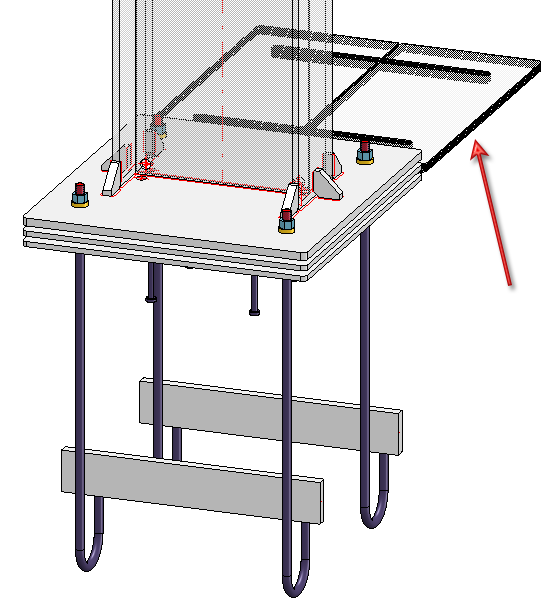
Non-pre-planned filer plates
Filler plates are not assigned to the assembly of the beam, but will be placed in a separate structure assembly called Loose parts. They obtain the usage Filler plates.
 If the bore grid is too narrow, preventing the fitting of filler plates, the plate will not be created. However, a feature log entry will be created.
If the bore grid is too narrow, preventing the fitting of filler plates, the plate will not be created. However, a feature log entry will be created.

Double-click the name of the feature to change the settings.
Here you determine the profile for the shear connector, its length and its material. Click the  icon to select the profile and the material directly from the corresponding standard part cataogues.
icon to select the profile and the material directly from the corresponding standard part cataogues.
Beneath Positioning you can specify an offset of the shear connector in relation from the plate.
Here you specify whether head studs are to be fitted. If so, activate the Fit checkbox and select the desired bolt.
Beneath Positioning you determine how the head studs set is to be aligned horizontally or vertically on the plate.
Here you have the option to attach additional stiffeners - so-called ribs - to flange or web.
For each of the possible stiffeners (2 and 5 to web, 1, 3, 4, and 6 to flange), the following parameter settings are possible:
Fit
By activating or deactivating this checkbox you specify whether the corresponding stiffener will be inserted or not.
AutoCalculate length
If this checkbox has been activated, the length of the stiffeners will be automatically calculated. If you do not want this, deactivate the checkbox and enter the length yourself.
Height, Chamfer X, Chamfer Y
Here you specify the height of the stiffener and the chamfer length in X- and Y-direction.
Process corner
Here you define the processing of the inner corner of the of the stiffener. Possible settings are:
Depending on the selected option, enter either the chamfer length or the fillet radius.
Click the  icon to apply the settings specified in the current input area to all other stiffeners in this direction. For instance, if you process area 1, i.e. in flange direction, and then click on the icon, the settings in the areas 3, 4 and 6 will be adjusted automatically.
icon to apply the settings specified in the current input area to all other stiffeners in this direction. For instance, if you process area 1, i.e. in flange direction, and then click on the icon, the settings in the areas 3, 4 and 6 will be adjusted automatically.

Connections + Variants (3-D SE) • Dialogue Window for Connections (3-D SE) • The Catalogue System for Connections + Variants (3-D SE)
|
© Copyright 1994-2020, ISD Software und Systeme GmbH |
Data protection • Terms and Conditions • Cookies • Contact • Legal notes and Disclaimer